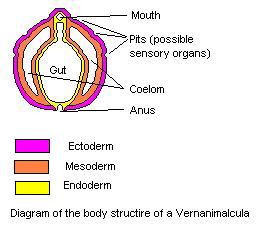Vernanimalcula
| Vernanimalcula | ||||||||||||
|---|---|---|---|---|---|---|---|---|---|---|---|---|

Scheme drawing of Vernanimalcula guizhouena . |
||||||||||||
| Temporal occurrence | ||||||||||||
| Ediacarium | ||||||||||||
| 600 to 580 million years | ||||||||||||
| Locations | ||||||||||||
|
||||||||||||
| Systematics | ||||||||||||
|
||||||||||||
| Scientific name | ||||||||||||
| Vernanimalcula | ||||||||||||
| Chen et al., 2004 | ||||||||||||
| Art | ||||||||||||
|
Vernanimalcula guizhouena is supposedly the earliest known representative of the Bilateria (animals with bilateral symmetry ). A re-analysis of the fossilized material has shown, however, that it is even questionable whether it is fossilized and that it was certainly not a bilaterer.
Controversial hypothesis of a triploblastic animal
It lived about 600 to 580 million years ago. It was between 0.1 and 0.2 mm in size and likely fed on microbes on the ocean floor. Its locomotion was possibly similar to that of a snail. Vernanimalcula means "spring animal " (Latin vernus = "spring", animalcula = "little animal" from animal = "animal"), which refers to its appearance in fossils after the end of the cryogenium , an ice age (see also snowball earth ) .
The Vernanimalcula fossils were discovered in the Doushantuo Formation in Guizhou , China. This fossil deposit is one of the rare places where soft body parts and fine structures in fossils have been preserved. The Vernanimalcula fossils show three cotyledons , a coelom , a differentiated gastrointestinal tract , a mouth, an anus and pair of external depressions that could be sensory organs .
The appearance of vernanimalcula in these early fossils is of great concern. It reduces the likelihood that animals without coelom , such as flatworms , could have developed before animals with coelom. The splitting of the animals into many phyla could have taken place before the size of the animals exceeded microscopic dimensions. The sudden appearance of many animal phyla in the Cambrian Explosion could be a fallacy; instead, existing tribes could independently have developed larger forms with well petrified body parts (e.g. tanks) in a (geologically) short period of time.
Vernanimalcula was first used by Juan-Yuan Chen (Nanjing Institute of Geology and Palaeontology) et al. described. Various objections were raised against the classification of Vernanimalcula as a triploblast, among other things, it was speculated that it was a more simply built animal, around whose body there were mineral crusts that falsely suggested a more complex structure.
Web links
swell
- David J. Bottjer : The early evolution of animals . Spectrum of Science April 2006
Individual evidence
- ↑ Bengtson, S., Cunningham, John A .; Yin, Chongyu and Donoghue, Philip CJ: A merciful death for the "earliest bilaterian", Vernanimalcula. . In: Evolution and Development . 14, No. 5, 2012, pp. 421-427. doi : 10.1111 / j.1525-142X.2012.00562.x .
- ↑ Chen, JY, DJ Bottjer, P. Oliveri, SQ Dornbos, F. Gao, S. Ruffins, H. Chi, CW Li, EH Davidson: Small bilaterian fossils from 40 to 55 million years before the cambrian . Science 305, 2004: 218-222. ( Abstract , accessed June 20, 2007)
- ↑ Bengtson, S., Budd, G .: Comment on "small bilaterian fossils from 40 to 55 million years before the Cambrian." . In: Science . 306, 2004, p. 1291a. doi : 10.1126 / science.1101338 . Retrieved June 27, 2007.